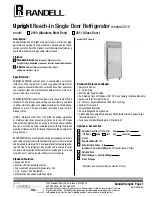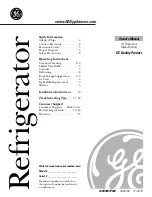
4
Electrical Requirements
Before you move your refrigerator into its final location, it is
important to make sure you have the proper electrical connection.
Recommended Grounding Method
A 115 volt, 60 Hz, AC only, 15- or 20-amp fused, grounded
electrical supply is required. It is recommended that a separate
circuit serving only your refrigerator be provided. Use an outlet
that cannot be turned off by a switch. Do not use an
extension cord.
NOTE: Before performing any type of installation or cleaning, or
removing a light bulb, turn cooling off or turn the control
(Thermostat, Refrigerator or Freezer Control depending on the
model) to OFF, and then disconnect the refrigerator from the
electrical source. When you are finished, reconnect the
refrigerator to the electrical source and turn cooling on or reset the
control (Thermostat, Refrigerator or Freezer Control depending on
the model) to the desired setting. See “Using the Controls” in the
User Instructions, User Guide, or Use & Care Guide.
Water Supply Requirements
Gather the required tools and parts before starting installation.
Read and follow the instructions provided with any tools listed
here.
TOOLS NEEDED:
IMPORTANT:
■
All installations must meet local plumbing code requirements.
■
Do not use a piercing-type or
³⁄₁₆
" (4.76 mm) saddle valve
which reduces water flow and clogs more easily.
■
Use copper tubing and check for leaks. Install copper tubing
only in areas where the household temperatures will remain
above freezing.
■
For models with water filters, the disposable water filter
should be replaced at least every 6 months.
Water Pressure
A cold water supply with water pressure of between 35 and
120 psi (241 and 827 kPa) is required to operate the water
dispenser and ice maker. If you have questions about your water
pressure, call a licensed, qualified plumber.
Reverse Osmosis Water Supply
IMPORTANT: The pressure of the water supply coming out of a
reverse osmosis system going to the water inlet valve of the
refrigerator needs to be between 35 and 120 psi (241 and
827 kPa).
If a reverse osmosis water filtration system is connected to your
cold water supply, the water pressure to the reverse osmosis
system needs to be a minimum of 40 to 60 psi (276 to 414 kPa).
If the water pressure to the reverse osmosis system is less than
40 to 60 psi (276 to 414 kPa):
■
Check to see whether the sediment filter in the reverse
osmosis system is blocked. Replace the filter if necessary.
■
Allow the storage tank on the reverse osmosis system to refill
after heavy usage.
■
If your refrigerator has a water filter, it may further reduce the
water pressure when used in conjunction with a reverse
osmosis system. Remove the water filter. See “Water Filtration
System.”
If you have questions about your water pressure, call a licensed,
qualified plumber.
Connect the Water Supply
Read all directions before you begin.
IMPORTANT:
■
Plumbing shall be installed in accordance with the
International Plumbing Code and any local codes and
ordinances.
■
The gray water tubing on the back of the refrigerator (which is
used to connect to the household water line) is a PEX
(cross-linked polyethylene) tube. Copper and PEX tubing
connections from the household water line to the refrigerator
are acceptable, and will help avoid off-taste or odor in your ice
or water. Check for leaks.
If PEX tubing is used instead of copper, we recommend the
following Whirlpool Part Numbers:
W10505928RP (7 ft [2.14 m] jacketed PEX),
8212547RP (5 ft [1.52 m] PEX), or
W10267701RP (25 ft [7.62 m] PEX).
■
Install tubing only in areas where temperatures will remain
above freezing.
■
If you turn on the refrigerator before the water line is
connected, turn off the ice maker to avoid excessive noise or
damage to the water valve.
■
Flat-blade screwdriver
■
⁷⁄₁₆
" and
¹⁄₂
" Open-end or two
adjustable wrenches
■
¹⁄₄
" Nut driver
■
¹⁄₄
" Drill bit
■
Cordless drill
Electrical Shock Hazard
Plug into a grounded 3 prong outlet.
Do not remove ground prong.
Do not use an adapter.
Do not use an extension cord.
Failure to follow these instructions can result in death,
fire, or electrical shock.
WARNING





































